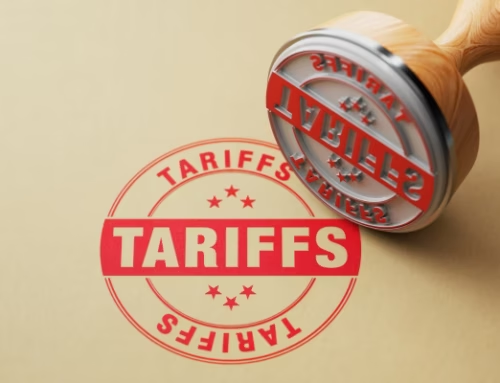Higher interest rates should weaken economic growth, which over time weakens corporate earnings and then share prices. But there’s a more direct and maybe faster connection between rates and the stock market. A stock’s current price is the discounted present value of its anticipated future income stream, compared to the available alternatives. Stocks compete for capital against other asset classes like bonds. So if bonds yield significantly more than investors think they can get from stocks, stock prices will reflect it. And that’s starting to happen now. Source: Tellimer Research The chart shows the two-year Treasury yield vs. the S&P 500 dividend yield.

The difference right now is the greatest seen since 2007, and it’s not in stocks’ favor. How this affects your investment decisions depends on your goals. Small speculators often don’t care about dividends. Large institutions usually do… and they may have more influence on the market’s direction.
Europe’s Credit Crisis
This morning, the Bank of England acknowledged U.K. markets were in trouble; a credit crisis was brewing.
As we first reported last Monday, the British pound has been crashing amid the financial policies of a new prime minister and a strengthening dollar. Now, the Fed’s peer in England has thrown in the towel already and “pivoted” – kind of…
Today, the Bank of England announced it would start buying long-term bonds to “restore orderly market conditions” at “whatever scale is necessary.” The central bank said a “repricing of U.K. and global financial assets” became significantly worse yesterday, and…
Were dysfunction in this market to continue or worsen, there would be a material risk to U.K. financial stability. This would lead to an unwarranted tightening of financing conditions and a reduction of the flow of credit to the real economy.
In line with its financial stability objective, the Bank of England stands ready to restore market functioning and reduce any risks from contagion to credit conditions for U.K. households and businesses.
In other words, “credit crisis.” Specifically, certain leveraged pension funds in England were reportedly facing hefty margin calls and were selling long-term bonds to meet them. So now the central bank is buying as much as $69 billion worth of bonds maturing in 20 years or more.
Mind you, this is while the Bank of England is also raising interest rates to fight inflation and had plans to sell bonds, or start “quantitative tightening,” next week – plans it put on pause today. On Twitter, Bloomberg TV anchor Jonathan Ferro smartly called the new policy “quantitative confusion.”
Adding bonds to a central bank’s balance sheet won’t help lower record-high inflation, but it may save some people or businesses from going bankrupt tomorrow. It’s another Band-Aid, which contributed to a slightly weaker U.S. dollar today (and the S&P 500 Index popping nearly 2%), but it’s certainly not a cure for debt addiction.
Stanley Druckenmiller
The 69-year-old billionaire, who managed $12 billion as president of Duquesne Capital until 2010, is considered one of the best investors in the world. Reportedly, he has never had a down year in the markets. He has attributed that to “luck” and the timing of the calendar, but he’s being modest.
Druckenmiller is a big-picture thinker who trades in stocks, bonds, and currencies. He helped George Soros famously “break the Bank of England” by shorting the pound in 1992, making $1 billion in profit. And, more recently, Druckenmiller has been spot on with his outspoken analysis of the economy and markets in the past two years in particular.
Last year, during an interview with a group of students at the University of Southern California, he sounded the alarm on the Fed going overboard with stimulus and increasing the odds of high inflation.
At the time, I called his talk an epic rant that was worth watching. In it, he pointed out that the poor would suffer most in an inevitable bursting of the ongoing asset bubble.
Then, in June of this year, Druckenmiller was a rare voice in the wilderness… one of few people to point out that when inflation has topped 5%, the Fed has always had to raise rates to a level above the consumer price index (“CPI”) to successfully lower it.
A few months later, it’s finally becoming clear to Mr. Market that this is the Fed’s strategy – and that a higher-for-longer interest-rate environment is the likely outcome. As a result, as Druckenmiller said in a conference in New York today, forget about a “soft landing”…
Our central case is a hard landing by the end of ’23. I will be stunned if we don’t have recession in ’23. I don’t know the timing but certainly by the end of ’23. I will not be surprised if it’s not larger than the so-called average garden variety.
He also said that all of the factors that caused the record-long bull market last decade – near-zero interest rates and central bank support – are “not only stopping, they’re reversing every one of them. We are in deep trouble.”
US Economy
- The S&P Global Flash PMI report showed surprising resilience in the nation’s business activity. We saw signs of stability earlier this month in the World Economics SMI index.
- Manufacturing orders are back in growth territory (2nd panel).


- Manufacturing-sector hiring strengthened.
- Services are still contracting, but the PMI is back near 50.
- Price pressures remain elevated but have started to ease.
- A separate survey from Evercore ISI also shows stability in business activity.

- But there is pain ahead for the economy as financial conditions tighten rapidly (2 charts).

- The market is now almost certain that we will get another 75 bps Fed rate hike in November and potentially in December.

- Goldman now sees 75 bps in November, 50 bps in December, and 25 bps in February.

- The FOMC members see extreme downside risks to their economic forecasts.

- Leading indicators point to slower business investment ahead.

- The Dallas Fed’s manufacturing index was softer than expected this month.
- Capacity utilization improved
- Expected production and new orders improved
- But expected business activity deteriorated.

- Home prices are too high relative to incomes.

- Realtor.com:

- Mortgage rates hit the highest level since 2008, …

- The spike in mortgage rates will be a significant headwind for economic activity.

- How much home can you buy with a $2,500 monthly mortgage payment?

The US Dollar
The U.S. dollar (USDOLLAR) is on the back foot last week, but the move down looks more like a one-day reprieve after the jump in the previous session and greenback strength is expected to continue.
Pound sterling hit an all-time low l, but BoE Governor Andrew Bailey ruled out an emergency hike in rates between meetings. In addition, the People’s Bank of China said it is raising risk reserve requirements for banks involved in forward foreign exchange trading to 20% from 0%.
The greenback’s strength is also a problem for stocks, but could hasten the end of the bear market, according to Morgan Stanley.
The “recent move in the US dollar creates an untenable situation for risk assets that historically has ended in a financial or economic crisis, or both,” equity strategist Mike Wilson said. “While hard to predict such ‘events,’ the conditions are in place for one, which would help accelerate the end to this bear market.”
“In the meantime, we remain convicted in our eventual low for the S&P 500 (SP500) (SPY) coming later this year/early next between 3000-3400 (in line with our base and bear case tactical views, respectively),” Wilson said. Goldman has a similar downside S&P target at 3,000, which would represent a -37% decline.
“On a year over year basis, the $USD is now up 21% and still rising,” he added. “Based on our analysis that every 1% change in the $USD has around a -0.5% impact on S&P 500 earnings, 4Q S&P 500 earnings will face an approximate 10% headwind to growth all else equal.”
“This is in addition to other headwinds we have been discussing for months – i.e., payback in demand and higher costs from inflation to name a few. It’s also important to note that such US dollar strength has historically led to some kind of financial/economic crisis.”
“What’s amazing is that this dollar strength is happening even as other major central banks are also tightening monetary policy at a historically hawkish pace,” Wilson said. “If there was ever a time to be on the lookout for something to break, this would be it. Like our rates team, our currency team raised its forecast for the USD. On a $USD basis, they are now forecasting a year-end target of 118, which means no relief in sight, at least fundamentally speaking.”
“In our view, such an outcome is exactly how something does break, which leads to MAJOR top for the US dollar and maybe rates, too. However, until that happens, we think the screws will only get tighter for earnings growth and financial conditions.”
“US rates are rising as the market reprices peak Fed Funds higher, and equities are being repriced lower,” Societe Generale macro strategist Kit Juckes said. “This has all the hallmarks of the start of the final stage of the dollar’s rally (a stage which has the capacity to be violent and volatile).”
From a technical standpoint, BTIG’s Jonathan Krinsky says that the dollar index has room to move up to 120 (it stands below 114 at the moment), but that it at least needs to pause for equities to bottom.
Foreign exchange volume is also at a critical level, Krinsky said.
Volume hasn’t “spent much time above 12 in the last decade,” he said. “Doing so would suggest something might be breaking, but also tends to indicate capitulation ala March 2020.”
The Fed
The Fed has more wood to chop to dampen consumer demand.

Source: Oxford Economics
Recession Risk
- The yield curve inversion boosted the probability of a recession in the next few months

Source: Alpine Macro
- Recessions tend to get triggered when the fed funds rate reaches the misery index.

Source: TS Lombard
- Most economic indicators experience varying degrees of positive growth during the two quarters prior to a recession. However, immediately following the onset of a recession, all indicators simultaneously decline.

Source: St. Louis Fed Read full article
- So far, industrial production and employment are still in growth mode despite this year’s technical recession (2 charts).
 Source: St. Louis Fed Read full article
Source: St. Louis Fed Read full article

Source: St. Louis Fed Read full article
Interest Rates and the Stock Market
Higher interest rates should weaken economic growth, which over time weakens corporate earnings and then share prices. But there’s a more direct and maybe faster connection between rates and the stock market. A stock’s current price is the discounted present value of its anticipated future income stream, compared to the available alternatives. Stocks compete for capital against other asset classes like bonds. So if bonds yield significantly more than investors think they can get from stocks, stock prices will reflect it. And that’s starting to happen now. Source: Tellimer Research The chart shows the two-year Treasury yield vs. the S&P 500 dividend yield.

The difference right now is the greatest seen since 2007, and it’s not in stocks’ favor. How this affects your investment decisions depends on your goals. Small speculators often don’t care about dividends. Large institutions usually do… and they may have more influence on the market’s direction.
Market Data
- The S&P 500 held support at the June low. The index now appears to be oversold.

- Market bottoms tend to occur in October.

- The US dollar surge continues to be a headwind for stocks.

- More earnings downgrades are coming.

- The 2008 analogy is holding.

- Big tech stocks have been hammered in recent weeks. The percentage of stocks in the Nasdaq 100 in short-, medium- and long-term uptrends has plummeted to one of the lowest readings since 1985.
- The drawdown in US equity and fixed income markets has been extreme.

- The S&P 500 is at support, with technical indicators (such as the RSI) pointing to a market bounce. The Nasdaq and Small Cap Russell have similar charts.

- Investment managers’ exposure to stocks reached the 2020 lows.

- The Dow Jones Industrial Average is breaking down.

Quote of the Week
Winning isn’t everything, but wanting to win is.
– Vince Lombardi (football coach)
Picture of the Week
The US marriage rate since 1990:

All content is the opinion of Brian J. Decker





